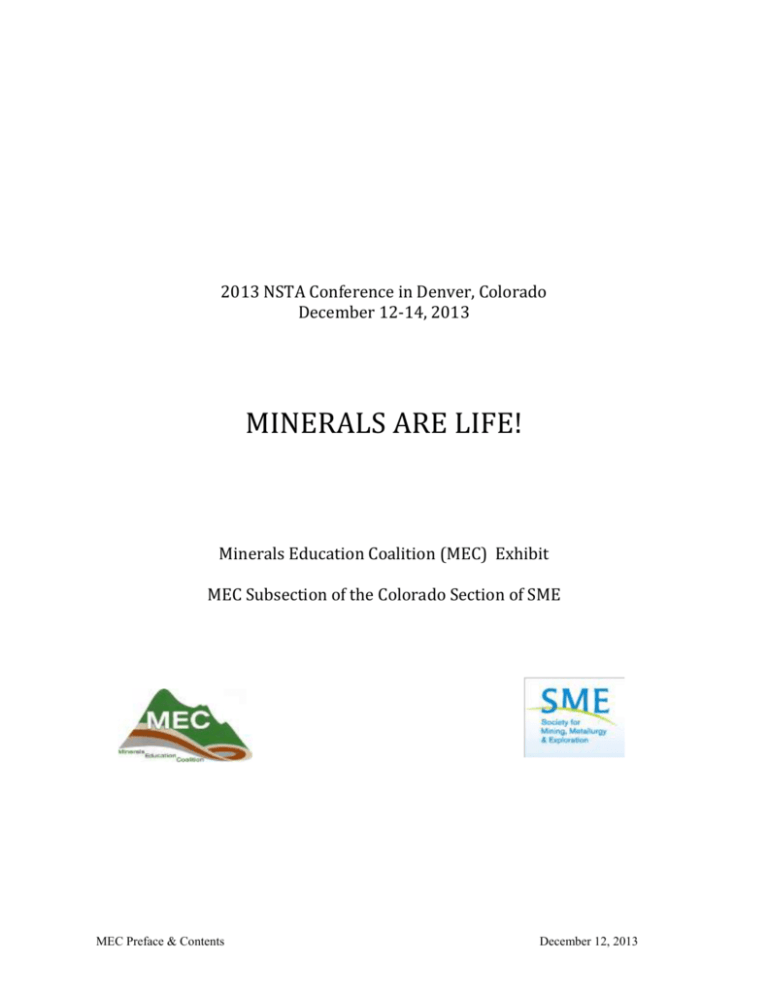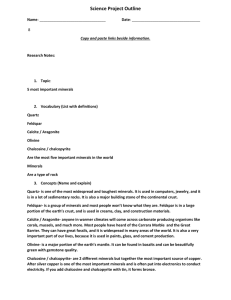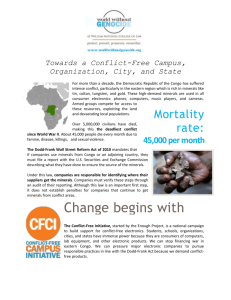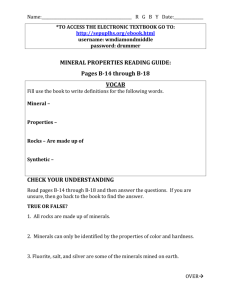2013 NSTA Conference in Denver, Colorado December 12
advertisement

2013 NSTA Conference in Denver, Colorado December 12-14, 2013 MINERALS ARE LIFE! Minerals Education Coalition (MEC) Exhibit MEC Subsection of the Colorado Section of SME MEC Preface & Contents 1 December 12, 2013 PREFACE Welcome to MEC’s world of rocks and minerals. We love our rocks and minerals so much that sometimes we eat them. That’s right! We eat them. That’s what our exhibit was all about. This flash drive is a compilation of the things you learned at our exhibit. It reminds you about the rocks and minerals we eat, the ones used to grow our foods, and the ones that are essential to our body’s health. The largest item you got from us was a box containing eight separate minerals. Potash Fuller’s earth Titanium minerals Limestone Gypsum Salt Iron Trona A diagram in the rock box tells what each mineral is called and its source. More detailed background information is included on this flash drive about the minerals in the box and their benefits as a food and for our health. That information can be found on this flash drive in File #2, “Minerals in the Box”. The box has a compartment to contain some tools for identifying minerals. Magnifying glass (called a loupe) with 10x magnification Two streak plates (one white and one black) to determine the real color of a mineral. Several objects of varying hardness (penny, nail, glass plate.) Use these for comparison with your minerals to determine their hardness. The tools in the mineral box are helpful for identifying minerals. They help to determine crystal shape, hardness, and streak color. The naked eye determines the surface color and luster of the minerals, but surface color MEC Preface & Contents 2 December 12, 2013 and streak color may not be the same. Mineral identification can be complex. File #3, “Mineral Identification” shows many of the identifying characteristics of minerals. How to use the tools in the box is also explained. There were three demonstrations at the exhibit. All of them can be performed in the classroom. These demonstrations are described in File # 4, “Demonstrations at NSTA,” on this flash drive. One of them described the use of the tools in the mineral box for identifying minerals. A second demonstrated that iron particles actually exist in our cereals and they can be removed with a magnet. The third demonstrated that carbon dioxide (CO2) is produced from baking powder. When a tiny submarine is filled with baking powder, it sinks; when the baking powder gets wet, CO2 bubbles are formed and the submarine rises. A comparison with baking soda will help explain the difference in the two similar baking products. The Women In Mining members made toothpaste in a separate workshop. Reference to this activity can be found in File #5, “Toothpaste Activity.” This demonstration supports many teaching standards and can easily be performed in the classroom. The benefit? The students learn about the ingredients in toothpaste. MEC would be remiss if we didn’t alert you to the fact that the minerals business needs hundreds of different kinds of expertise from scientists to equipment operators and from accountants to professors. Alert your students about these opportunities. Our booklets explaining some career options are included in File #6, “Careers in Mining”, on this flash drive. The MEC Subsection of the Colorado Section of SME has a cadre of speakers who are experienced classroom presenters. File #7, “Speakers Bureau,” on this flash drive tells how you can request a speaker from us. Giving you websites that we have reviewed for good content saves you time and minimizes frustration. File #8, “Web Sites,” of this flash drive gives websites that have been reviewed for their content about the minerals/elements in foods, in agriculture, and in our bodies. We believe you will find them useful. MEC Preface & Contents 3 December 12, 2013 Acknowledgements Many organizations and people contributed the knowledge you gained at the MEC exhibit. The unsung presence behind nearly all of these contributors is SME (Society for Mining, Metallurgy and Exploration, Inc.). It is the technical society whose purpose is to be THE resource and advocate for the mining community. MEC (Minerals Education Coalition) is the public outreach arm of SME. The MEC organization responsible for the ‘Minerals Are Life!’ exhibit at the Denver conference you attended is the MEC Subsection of the Colorado Section of SME. Listed are the organizations and people that made the exhibit possible. MEC Subsection members MEC Staff Colorado School of Mines student chapter of SME Colorado Section of SME Women In Mining Harrison Western Intrepid Potash Active Minerals International, LLC Cliff Natural Resources DuPont Titanium Technologies U. S. Department of Energy Underground Salt Museum FMC Corporation American Gypsum Pioneer Sand Company, Inc. Hazen Research, Inc. Daltile Tim O’Neil Rocky Coal Mining Institute Caterpillar Wyoming Analytical Laboratories, Inc. Florida Geological Survey Gibbs Associates The world of minerals is an exciting one. Pass on the excitement by teaching your students about the minerals highlighted at this “Minerals Are Life!” exhibit. MEC Preface & Contents 4 December 12, 2013









